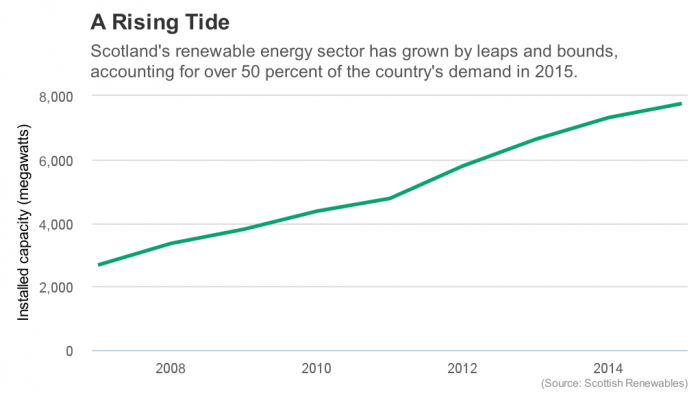Scotland Waves Hello to the World’s First Tidal Power Farm
Off the rugged coast of the Scottish Highlands, between the mainland and the majestic isles of Orkney, is a stretch of water that’s known for its intense tides. Now the country is making use of them, as the area is about to become home to the world’s first large-scale tidal energy farm.
The first of what will eventually become 269 turbines is currently being transported to the area, known as the Pentland Firth, for installation, reports the Guardian. Each turbine is a weighty piece of mechanical engineering, measuring 15 meters tall and weighing 200 metric tons, with eight-meter-long blades. Initially four turbines will be installed at the site, with the rest being added incrementally between now and the early 2020s to create something that will resemble a submerged version of a wind farm.
The site was chosen for the MeyGen tidal stream project because of its particularly strong tides, with currents that can move at up to five meters per second. Those waters will help each turbine produce 1.5 megawatts of power, adding up to a total of 398 megawatts—enough to power 175,000 homes—when the farm is complete.

Scotland is no stranger to renewables (see chart). At the end of 2015, the nation claimed an impressive 7.8 gigawatts of renewable electricity installations—with its output equivalent to 57.4 percent of total consumption. It aims for renewable electricity to account for 100 percent of its annual consumption by 2020.
But despite an abundance of strong waters, wave and tidal power accounted for just eight megawatts of the country’s total installed capacity in the first quarter of 2016, compared to 5,520 megawatts of onshore wind. Arguably, the project is notable for happening at all: tidal energy has struggled to take off because it’s so expensive to build out the required infrastructure.

It’s unlikely that it will catch up with wind anytime soon. To the East of Pentland Firth, the North Sea is undergoing its second energy boom in the form of offshore wind. Most notably, the new Dogger Bank project will cover 360 square miles of the sea with 400 wind turbines, providing a capacity of 1.2 gigawatts—three times that of the MeyGen project—and other installations are also planned.
Tidal power, then, may not be the answer to Scotland's ambitious energy goals. But as the field of turbines on the ocean floor grows, the country will for the first time make use of an energy resource that quite literally surrounds it.
(Read more: The Guardian, “Why Hasn’t Tidal Power Taken Off?” “Wind Fuels the North Sea’s Next Energy Boom”)
Keep Reading
Most Popular
Large language models can do jaw-dropping things. But nobody knows exactly why.
And that's a problem. Figuring it out is one of the biggest scientific puzzles of our time and a crucial step towards controlling more powerful future models.
How scientists traced a mysterious covid case back to six toilets
When wastewater surveillance turns into a hunt for a single infected individual, the ethics get tricky.
The problem with plug-in hybrids? Their drivers.
Plug-in hybrids are often sold as a transition to EVs, but new data from Europe shows we’re still underestimating the emissions they produce.
Google DeepMind’s new generative model makes Super Mario–like games from scratch
Genie learns how to control games by watching hours and hours of video. It could help train next-gen robots too.
Stay connected
Get the latest updates from
MIT Technology Review
Discover special offers, top stories, upcoming events, and more.